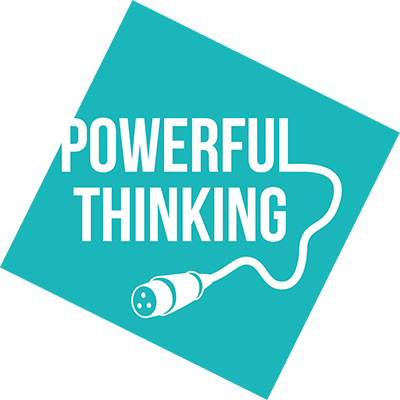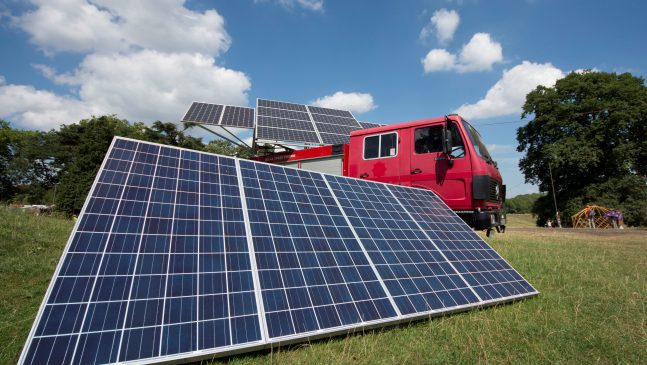By – Tessa Stewart, REsource Living & Em Weirdigan, The Green Gathering
While many people like the idea of solar power, it tends to be seen as too puny and unreliable to be a realistic option for most festivals and events.
In this blog the organisers of The Green Gathering – a 5000 capacity, 100% renewably-powered festival – along with power providers REsource Living – bust some common myths about using solar successfully to encourage more festivals to make the switch. They have plenty of experience to share! The Green Gathering received the International Greener Festival Award for Power in 2018, and they are a Vision: 2025 event, pledged to cut their environmental impacts year on year.
Myth 1: “For our headline bands only a generator will do”
Tess of REsource Living, one of The Green Gathering’s power providers, replies:
Tackling this calls for a relationship between musicians, sound engineers and power managers.
There are now digital amps available that provide sound quality just as good as valve amps for a fraction of the power requirement. Experienced musicians know this. Sound engineers know that a PA will not run at its peak output rating, for example a 10kW PA will rarely require 10kW and the sound quality is far better below this, at around 50%.
Resource Living sometimes uses a meter on the sound engineer’s desk so they can actually see how much power they draw; the idea being to get them on board so they feel in control, and talk to them so they understand that being savvy now will mean there’s plenty of power for later and tomorrow.
A band requiring a 10kVA feed will rarely use that much and if they do it will be in spikes which a correctly sized solar system will be able to handle. Resource’s current inverters can spike at 12kVA for 30 secs.”
Low-energy LED lighting equipment is now easy to source – festoon for area lighting, floods for gates and carparks, stage lights and spots. There are plenty of talented lighting engineers happy to work on solar powered systems.
Myth 2: “If the sun goes in, it won’t work… where’s the back up?”
Good solar power providers have back up inverters and charge controllers and so could continue to provide at least half capacity if something went wrong.
It’s unlikely to happen though; there are no moving parts in a solar powered system so it is lesslikely to fail than a diesel generator. When something goes wrong with a generator there’s often no warning, whereas with solar there’s constant monitoring and calculations about how much longer a particular load can be run for. If an input has failed it’s noticed very quickly and can usually be diagnosed easily.
Myth 3: “Solar’s ok for an acoustic stage but it can’t power a whole festival…”
Several events of around The Green Gathering’s size (5000 capacity) are totally solar powered. Most things can be scaled up and replicated on a larger scale. There are two ways to power a whole festival from solar; at The Green Gathering both versions are used.
1/For centrally located power needs; a temporary power grid is set up, with load sharing between the main power providers. If any one provider is low on storage they can share loads with another provider; when someone is generating surplus power they can take on more loads.
2/For more peripheral needs; independent solar providers are used, correctly matching each solar system to the equipment it will power. This method has advantages in that the need for long power cable runs is eliminated, but it needs careful consideration before the event to correctly match provider to need. Essential consumption is calculated and a worst case weather scenario is used to do the calculations… then if it’s sunny the lights can be brighter, the music louder and the ice machine can chug away because there’s plenty of power!
To run a large festival on solar, the main barrier is likely to be cost. If the budget won’t stretch to it or you can’t find enough reliable providers available for your event date, how about having dedicated solar powered areas within the festival?
Campsites, wellbeing areas, children’s areas, craft areas and workshop zones use relatively little power. Using solar power in these areas decreases noise and air pollution and increases awareness and power security for that area.
There are also several solar providers who can provide a stage sized correctly for their solar system.
Myth 4: “You can get solar powered stages but what about the caterers and traders, they all need 16A feeds…”
It’s a myth that caterers and traders need a 16A feed. 16Amps at 240 Volts is 3.8 kW. Some caterers may peak at that or even more if they use a lot of electrical equipment and likewise traders could use eight 500W halogen bulbs to max out a 16A feed… but if we are in the business of sustainable festivals then our choice of traders and caterers can and should reflect this!
Traders and caterers unused to running off solar probably have little idea how much power they use but equipment is labelled with peak wattage and users usually know roughly how many hours they need the lights on and how frequently they use other equipment, so needs can be calculated. A good power provider can help traders understand which equipment is power hungry and offer suggestions (use blenders during the day rather than at night, for example).
Tess explains:
“We have replaced inefficient lighting in stalls with LEDs, and said no to microwaves, bain maries etc… but more often than not stalls are okay to plug their juicers, toasters and food processors in, providing we keep an eye on usage. A 3kW appliance could only require 3kWh a day if it’s only used minimally, which is equivalent to having a constant load of 125W. When we power people we don’t just hand them a plug, they get a lesson in applied power! We have signs reminding them the power is from the sun and to plug anything they can in during the day, when the sun is out. That’s not to say they can’t use power when it’s dark – of course they can, the power from daytime sun is stored in batteries to be used at night – but it’s more efficient to use it during the day, when there’s more sunlight coming in than the batteries can store.”
Generators are often oversized because need is calculated based on peak values rather than actual running values. The advantage with solar is that individual stalls can be monitored and their average consumption worked out over time in kilo-Watt Hours (kWh).
Myth 4: “We need power before and after the event so must get a generator for the week”
There is nothing more irritating than a generator humming away in an empty field with one light and a laptop plugged in…
Before and after an event are some of the lowest power requirements. Often massive generators are on site, running well under load, burning fuel unnecessarily, keeping people awake and encouraging people to leave lights and equipment on.
Thinking about how to streamline power use pre and post-event and using solar during these times could cut the amount of fuel used considerably.
Conclusion
- By only using stall-holders with low power requirements (or even better their own solar power system) we can seriously reduce trader loads.
- By using food stalls which use gas or wood fired ovens to cook some or all of their food we can seriously reduce caterer loads. Working with caterers to manage appliance use for best power efficiency is very possible.
- By hiring self-powered solar stages we can reduce stage loads significantly.
- By telling bands how much power they can have, instead of asking how much they want we can seriously reduce stage loads.
- By learning what power we actually need where, power provision becomes increasingly efficient and solar power becomes a feasible option.
- A new way of thinking, of awareness, is all that’s required to move from generators to solar in many, if not all, areas of a festival. When people say it can’t be done what they are really saying is they can’t be bothered. It takes more thinking and organising to be efficient. It takes communication, compromise, maybe a little scaling down, preparedness to work co-operatively and mindfully.
- The planet doesn’t have infinite resources and our festivals need to respect and reflect that if they’re to have the feel-good factor we’re all chasing!
- There’s nothing better than cranking up the music on a sunny Sunday because everyone has used the power thoughtfully throughout the festival. The music actually feels better when you realise it’s coming straight from the sun!
To get in touch with REsource Living visit: www.resourceliving.org

